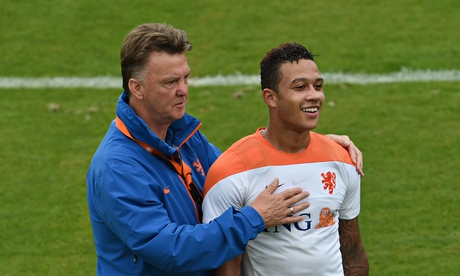
In the late 1980s two young coaches on opposite sides of the world came up with similar ideas about how football should be played. Both were deeply influenced by the Dutch total footballing sides of the early ’70s but both recognised the romanticism of that style had to be adapted to a world in which players were fitter than ever and pressing was widespread.
A quarter of a century on this is their World Cup, a breathtaking festival of thrust and counter-thrust, with transitions foregrounded and most teams looking to win the ball back high up the pitch. The majority of coaches at this World Cup have been influenced, directly or indirectly, by either Marcelo Bielsa or Louis van Gaal. And one of them is Louis van Gaal.
Of course, being Van Gaal, he has not fitted comfortably into the narrative. His idealism has been tempered and, while certain traits remain the same as ever – the insistence on discipline, the combative approach to press conferences, the majestic brick-faced self-certainty –this is an older, wiser, more flexible Van Gaal, one who understands the value of compromise.
Holland’s 2-0 win against Chile in the final game of the group stage was a masterclass. In Jorge Sampaoli Van Gaal faced a self-professed disciple of Bielsa, somebody he knew would press and look to disrupt the natural passing patterns of his side high up the pitch. Tactically speaking, he was essentially looking into a mirror.
The old Van Gaal might have accepted Sampaoli’s challenge to fight mano a mano, might have sought to show that nobody beat him at his game. This Van Gaal, though, sat off, defended deep and waited for an opportunity to exploit Chile’s lack of central defensive height at a set play. He had noticed, Van Gaal said, that Chile’s level tended to drop in the last 10 to 15 minutes, so he bided his time; sure enough, Arjen Robben picked Chile off on the break to cross for Memphis Depay to add a second in injury time.
Afterwards Van Gaal, who takes over at Manchester United after the tournament, was challenged as to whether he was somehow betraying the Dutch style by not playing what the journalist in question termed “attacking football”. Van Gaal’s response was typically belligerent as he asked the journalist to define “attacking football”.
The implication, that attacking football is not simple to define and is somehow in the eye of the beholder, seems to have become increasingly relevant over the past decade. The former logic that possession football equalled attacking football no longer pertains. Germany, for instance, were praised for their attacking play at the last World Cup but they were a reactive side, countering with thrilling vibrancy. The opposite is true of Spain, a radically proactive side dismissed by some as being boring despite – or rather because of – their mastery of the ball.
Van Gaal’s philosophy was never as possession-oriented as that of Rinus Michels or Johan Cruyff but still his Ajax and Barcelona sides and the foundations he laid at Bayern Munich were clearly derivative of the old school of Dutch football, even if they were opposed by Cruyff and other Ajax romantics. He favoured a 4-3-3 with a playmaking central defender who stepped up into midfield, later incorporating an additional holding midfielder and adjusting to a 4-2-3-1.
The switch to a counterattacking style has taken many by surprise, as has the dabble with three central defenders. Van Gaal has pointed out, quite rightly, that he won the Eredivisie with AZ Alkmaar playing counterattacking football without traditional wingers, but the change of shape was seemingly an emergency measure undertaken after the injury to Kevin Strootman.
The Roma midfielder was injured in the 2-0 friendly defeat by France in March, a match that was decisive in the evolution of this Dutch side. Karim Benzema tore Bruno Martins Indi apart and Van Gaal decided he could not risk his defenders being left one on one against top-class strikers. That meant bringing in an additional defender as cover and the switch to a back five. Happily three of his defence – Martins Indi, Stefan de Vrij and Daryl Janmaat –played together at Feyenoord in a side that occasionally operated with three central defenders. They were coached by Ronald Koeman, whom Van Gaal had disliked and distrusted at Ajax, but his pragmatism overrode that and he went with Van Persie, his captain, to watch a Feyenoord game. They came away enthused and Van Gaal then telephoned Arjen Robben to persuade him of the value of moving away from the more traditional approach.
Van Gaal was badly burned by his first spell as Holland coach, which ended in failure to qualify for the 2002 World Cup. He recognised that, given the lack of time available to coaches at national level, it is almost impossible to institute the sort of overarching philosophy he would with a club side. Instead he has opted for a more piecemeal approach, essentially creating a platform for Wesley Sneijder to create and looking to exploit the pace of Robben, whose switch from left to right after the drinks break in the Mexico game was critical.
Van Gaal has never been as hung up on ideology and playing the right way as many other Dutch coaches but this tournament has highlighted his ability to micromanage as well as philosophise. His only interest, he says, is winning, a pragmatism that, in the Dutch context, makes him as radical as ever.

